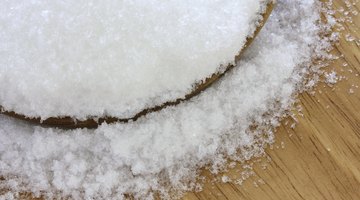How to Fertilize a Garden With Epsom Salts
All plants need the magnesium and sulfur provided by Epsom salts, but most plants get enough sulfur from prepared fertilizers and from acid rain, which is common throughout North America.

More plants lack magnesium, and Epsom salts provides plants with a quick and easily accessible source of that nutrient, especially when you apply the product in a liquid form. If you see yellowing leaves, leaf curling or stunted growth in your plants, it's worth giving Epsom salts a try.
Simple Soluble Solutions
Epsom salts dissolves easily in water, allowing you to add it to your watering can for use every other week as a fertilizer. Add as little as 1 teaspoon per gallon of water for geraniums (Pelargonium crispum), which grow outdoors in U.S. Department of Agriculture plant hardiness zones 1 through 9. Or, add 1 to 2 tablespoons at planting time for flowers or crops grown as annuals such as tomatoes (Lycopersicon esculentum) or peppers (Capsicum annuum), again when the plants bloom and finally after fruit or vegetable crops have set.
Foliar Spray
Adding Epsom salts to a spray bottle or tank sprayer allows you to dose the leaves directly and increase their ability to absorb magnesium. Use a dose of about 1 tablespoon of Epsom salts to 1 gallon of water and spray the plant's leaves until they are wet, starting when the leaves first appear in the spring and again about four times during the growing season, or about once a month for most plants.
Direct Ground Use
Although sprinkling Epsom salts directly on the ground does not allow your plants to absorb magnesium as quickly as they would if you dissolved the salts, it is still an effective method for plants whose roots are not too shallow. Use a trowel or spade to work in 1 tablespoon of Epsom salts per foot of soil at the bottom of each plant. Water the plants to help the salts reach the plant's roots, and reapply about once a month during the growing season.
Begin at Planting Time
Adding the Epsom salts to the bottom of planting holes gives new plants a head start on healthy growth, helping them to develop strong root systems and early cell development. Sprinkle 1 to 2 tablespoons for each large hole for shrubs, 1 to 2 teaspoons for smaller annuals or vegetables, and 1 to 2 teaspoons for planting seeds or very small transplants.
The Drip Cap
- All plants need the magnesium and sulfur provided by Epsom salts, but most plants get enough sulfur from prepared fertilizers and from acid rain, which is common throughout North America.
- Use a dose of about 1 tablespoon of Epsom salts to 1 gallon of water and spray the plant's leaves until they are wet, starting when the leaves first appear in the spring and again about four times during the growing season, or about once a month for most plants.
- Although sprinkling Epsom salts directly on the ground does not allow your plants to absorb magnesium as quickly as they would if you dissolved the salts, it is still an effective method for plants whose roots are not too shallow.
References
Writer Bio
Susan Lundman began writing about her passions of cooking, gardening, entertaining and recreation after working for a nonprofit agency, writing grants and researching child development issues. She has written professionally for six years since then. Lundman received her M.A. from Stanford University.
Photo Credits
- sasimoto/iStock/Getty Images
- sasimoto/iStock/Getty Images
More Articles


